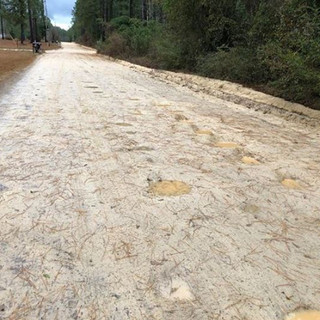Lexington, SC (Paul Kirby) – In every corner of Lexington County there are some dirt roads that are the only way that people can get from point A to point B. The further southeast and west, the more common they are. The more dirt roads an area has, the more calls that area’s county councilman receives about the condition of those roads. Occasionally, frustrated residents contact the media, too. They feel their voices aren’t being heard or want to “shame” the county for the bad roads. Recently, The Lexington Ledger got just such a message and since its owner lives on a dirt road, and has for 20-years, we decided to investigate the situation regarding dirt roads and their maintenance.
First, there are 2,760 miles of publicly maintained roads in Lexington County. The South Carolina Department of Transportation maintains 1,510 miles of road in Lexington County, while Lexington County maintains 1,250 miles, more than half of which are drt. There are some state-owned dirt roads, too, but we’ll leave that confusion for another time. The county doesn’t accept any new dirt roads into their system. If a new subdivision or business is being built, the county won’t consider accepting new roads for maintenance until they meet a certain standard. So how did the county end up with so many miles of dirt roads; They inherited them from years gone by when dirt was often the standard surface for travelling.
The county’s primary technique for dirt road maintenance is using a motor grader to smooth them out. No new dirt is brought in unless something major, like a flood, occurs. Public works tries to scrape most roads once every six or seven weeks, weather and manpower permitting. That weather catch is a big one. In the last six-months, we’ve had in excess of 30-inches of rain in our county. You can’t scrape roads when they’re wet or you’ll make “dirt soup”! If someone calls their councilmember or public works and gets an emergency grading of their road because it’s becoming dangerous or impassible, this throws everyone’s maintenance back a bit.
Lexington County’s motor graders each cost approximately $230,000. There are 18 motor graders distributed throughout the county just for dirt road maintenance. In total, buying those cost taxpayers over $4.1 million. They primarily run on diesel fuel and require regular lubrication and maintenance, too. The county currently pays $2.02 per gallon for this fuel and Lexington County Public Works used about 49,584 gallons last year at a cost of $1.1 million. A lot of it goes in the graders. Repairs on their graders are expensive. The county tries to rotate them out on a schedule as their operating hours climb to prevent breakdowns. Graders/Motor graders also don’t operate themselves; personnel costs are a huge part of the county’s budget.
Dirt roads are hard on other public equipment. School busses, sheriff’s department cars, and other county- or state-owned vehicles are not immune to dirt road wear and tear. The more they bang up and down dirt roads, the more often they need replacing. They are replaced by our tax dollars.
There are two distinctly different problems that plague the roads of Lexington County. In the north region, primarily north of US Hwy. 1, there is red clay and rock. Dirt roads in this area get potholes, puddles, and ripples, but the biggest concern is what happens when they get wet. Wet red clay is like ice, very slippery. This is not good for driving on at all.
In the south region, primarily below US Hwy. 1, there is sand or a sand-clay mix. Roads in these areas don’t hold their surface long and get what is called a “washboard” effect in them very quickly. The ripples or washboards are most common near Gilbert, Batesburg-Leesville, Fairview, Pelion, Swansea or Gaston.
In both regions, one heavy rain storm is a gamechanger. Rain makes the clay roads slick and rough, and the sand roads wash out or get even more potholes and ripples. There’s also the problem of ponding or standing water that can only absorb into the ground over time. Both types also suffer from a unique disease called “Dig-It-Up-Itis.” That is the undeniable urge of every good ol’ boy or girl to take their 4x4 or ATVs and play on the roads, digging them up even worse after each rain. Fun? Yes. But, expensive for us to fix, too.
Lexington County Council Chairman Scott Whetstone says the county would like to pave approximately seven or eight-miles of dirt roads each year, it just rarely works out that way. Sometimes, they don’t meet this goal because they are saving their money for larger projects in the future. Most of the time, it’s simply a matter of a lack of funds. There are a few band-aids for the worst spot on the worst dirt roads, but the only real long-term fix is paving them.
The county has their own paving crew to make things cheaper but paving a mile of road usually cost between $800,000 and $1 million. If you round the miles of dirt road in the county to an even 600, and then you divided that by eight miles we’d like to pave each year, it would only take 75 more years to pave them all. Remember, eight miles a year is very optimistic. At today’s prices, that would be in excess of half a billion dollars! Let’s not think about what paving cost in 40, 50, or 60 years!
So, what hinders us from doing more paving? The first big stumbling block is money. C-Funds are the primary source of state revenues that Lexington County utilizes to pave roadways in the county, 25 percent of which must be expended on state-maintained roadways. C-Fund money is generated through gas tax money we pay at the pumps when we buy our fuels. Each time you buy gas or diesel, you pay Washington 18.4 cents in taxes, and South Carolina 20.75 cents. Diesel fuel taxes are even higher because big trucks are harder on the roads. Don’t complain about our gas taxes in South Carolina, our gas taxes are the second lowest in the nation. Compared to our neighbors, Georgia’s state gas tax is 31.6 cents, and North Carolina’s is 34.3 cents. C-Funds are collected by the state and returned to County Transportation Committee’s (CTC) using an allocation formula that is based on area (Sq. Mile), population and rural roads (centerline miles).
Lexington County is a donor county, because it contributes more gas tax to the C Fund program than what it receives using the allocation formula. The County receives a donor bonus check at the end of the fiscal year to return this excess amount. Typically, in the past, the County was not made whole from the donor bonus check sent back from the state. Since the state increased the donor bonus for donor counties, Lexington County was able to receive 100 percent of the funds it donated to the state in 2018, which was the first time in several years. Donor bonus funds are to be spent in accordance within the requirements outlined in the C Fund law, but the funds do not have to be spent on state-maintained roads. C Funds used to come from 2.66 cents per gallon of the state gasoline tax. The portion the state returns to Lexington County is gradually increasing to 3.99 cents because of the road bill that passed the legislature a few years ago. The first .3325 cents per gallon increase began July 1, 2018. The gas tax increases .3325 cents each year for four years. Beginning July 1, 2021, the 3.99 cents per gallon will be in effect. In the fiscal year 2018 - 2019, Lexington County is expecting to get about $5.2 million in gas taxes. Sounds great, right? Not so fast! The state mandates we spend 25 percent on the state system. This requirement will increase to 27 percent in fiscal year 2020-2021 and then go to 33 percent in fiscal year 2021-2022. The CTC’s will then have the original 2.66 cents to spend on their local road system and the 1.33 cents increase will have to be spent on the state system. I guess that’s fair because we drive on them the most. There are also eight categories the state mandates we must spend the gas tax money on. Transportation, economic development, special projects, drainage, asphalt maintenance, dirt road paving and subdivision bonds all get a slice of that money. That doesn’t include the 25 percent we spend to keep up the state roads. If you take that $5.2 million, remove 25 percent off the top, and then divide it into all eight categories, there’s not a lot left for paving dirt roads. Once divided, the funds left to Lexington County this year is about $2 million for paving dirt roads. That’s a bit over two miles of roads.
When Lexington County receives money for dirt to paved conversion, they turn to their petition list for the roads they’ll pave. This list was created by the 2009 county council. Did you know you need to petition to get you dirt road on the paving list? I didn’t and I checked; my road is not on there! Once you or a neighbor gathers enough signatures on a petition and submit it to the county, they prioritize the road. Factors like traffic, maintenance, the number of people who live off the road, school bus usage and the amount of time your road is on the list all plays a part in that.
Once you make the paving list and it gets prioritized, you may be lucky and make the top 25 approved list. Remember the factors? That’s how the top 25 are selected. The more factors your road has, the higher up the list you are. The approved list from 2009 has had 19 of the 25 roads complete. Eight are currently in design and are expected to be in construction by 2022 or 2023. One project was dropped. Remember, that’s the 2009 top 25 list! If I could get enough of my neighbors to sign the petition today, you could plant flowers on my grave by the time our road is paved at this rate.
Once you get on the list and start inching your way up, that doesn’t mean your road will eventually be paved. The county needs right-of-way and drainage easements along your road to get started. Most people give these because they want their road paved. Some don’t. If one land-owner refuses to deed the right-of-way to the county, just a small grass strip usually, your road could sink down the list or even get bumped off completely. You’d be surprised how many landowners on a road don’t want their road paved. The person who owns the land where your road connects to an existing paved road is key. If they say no easement, that’s almost a deal breaker; no paving for you and your neighbors.
Now that we’ve identified the problems paving our dirt roads, what’s the fix? It really takes a dedicated revenue stream for dirt road paving. Don’t look to the state. They have their own problems to solve like interstates and major bridges. State Sen. Katrina Shealy, R-Lexington, said recently regarding paving dirt roads, “That is a county issue no matter how you slice or fund it.”
There are just a few options available. One would be to raise county property taxes. The problem is, only people who own property would pay for paving. Many of us are already looking at higher taxes being implemented in District One by the school board, not the county council. Anyway, property taxes are very unpopular, and some say very unfair.
There’s a way to add another penny sales tax for every dollar we spend in Lexington County. That could work with the right people on a committee that’s required. They could agree to use the penny only for paving. Then we’d all pay just a little over time as we buy things and it wouldn’t be so painful. That could work.
Do you think cutting waste at the county level will do it? Is there a pot o’ gold at the end of some rainbow that could pave all these roads? If you believe there is, run for office and find it. For years, candidate after candidate has promised if elected, they’ll trim the fat to provide for one thing or another. In this author’s 25 or more years of following local politics, he’s never seen one find enough to make even a tiny ripple in the additional budget needs. We run a pretty tight ship as governments go. No, until another steady source for paving funding is found, people who live on dirt roads better enjoy them because they’ll be around for years to come.
The real question we have to face is are we going to keep dumping money into maintaining dirt roads at a steadily climbing price, or are we going to buck up and find a way to pay for paving dirt roads now? Continuing like we are is like pouring buckets of money on the ground every time that motor grader goes by. If a firetruck, an ambulance, a patrol car or anything else we pay for bangs down those roads, that’s more of our money being wasted. If it rains, it just washes our money away!
Twenty years ago, when I bought my property it was on a dirt road. Twenty years later, it still is, and I expect it may be for twenty more. That’s if I or one of my neighbors start the petition to get it on the list. If you have a suggestion that might work better, your county council member’s contact information is listed on the Lexington County website at https://lex-co.sc.gov/county-council.











